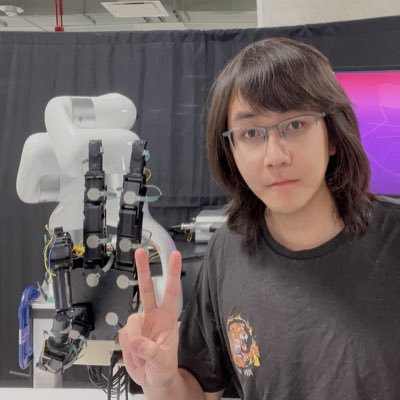
Han Xue
@HanXue012
Followers
675
Following
527
Media
13
Statuses
133
Ph.D. student @sjtu1896 | Interesed in Robot Learning & Manipulation
Joined October 2023
Reactive Diffusion Policy (RDP) is selected as Best Student Paper Finalist 🏆 in #RSS2025! I'll present RDP in tomorrow afternoon (Jun. 22) in the main conference. Welcome to chat more in the poster session!
Humans can easily perform complex contact-rich tasks with vision and touch, but these tasks remain challenging for robots. How can we resolve this from both the algorithm side and the data side? Introducing Reactive Diffusion Policy (RDP),a slow-fast imitation learning algorithm
3
6
67
Today, we present a step-change in robotic AI @sundayrobotics. Introducing ACT-1: A frontier robot foundation model trained on zero robot data. - Ultra long-horizon tasks - Zero-shot generalization - Advanced dexterity 🧵->
408
620
5K
Some of my favorites on reward modeling, RL, and robust VLA from the community: https://t.co/l2qsGM3iNl from @Jesse_Y_Zhang
https://t.co/vTkatrwsNe from @kunlei15
https://t.co/dt2Woi5Umx from @QianzhongChen and pi0.6 from @physical_int today: https://t.co/uXjEr1FsbB
0
15
101
RL feels messy, but a two-axis view—data source (on/off/offline) × update schedule (one-step/multi-step/iterative)—brings order. I wrote a post unifying them with shared equations. https://t.co/qJ7sx189RT Robotic FMs (e.g., GEN-0, pi_0.5) grow via a data flywheel. Best fit:
11
57
474
Real2Sim evaluation for deformable objects is very hard. Nice work from @kaiwynd!
🧵 Evaluating robot policies in the real world is slow, expensive, and hard to scale. During my internship at @SceniXai this summer, we had many discussions around the two key questions: how accurate must a simulator be for evaluation to be meaningful, and how do we get there?
1
0
3
Introducing GEN-0, our latest 10B+ foundation model for robots ⏱️ built on Harmonic Reasoning, new architecture that can think & act seamlessly 📈 strong scaling laws: more pretraining & model size = better 🌍 unprecedented corpus of 270,000+ hrs of dexterous data Read more 👇
49
286
1K
Imagine a future where we have a giant robot factory. How does the robot realize it has gone off track? Do we need to equip each of them with a human operator for safety's sake? Our answer is: No! Introducing ARMADA: Autonomous Online Failure Detection and Human Shared Control
9
58
327
Can robots learn from their own experiences like humans? How can they go beyond demonstrations to discover novel behaviors? ☕️Introducing SOE — Sample-Efficient Robot Policy Self-Improvement via On-Manifold Exploration! By constraining exploration to the manifold of valid
2
29
128
Tactile interaction in the wild can unlock fine-grained manipulation! 🌿🤖✋ We built a portable handheld tactile gripper that enables large-scale visuo-tactile data collection in real-world settings. By pretraining on this data, we bridge vision and touch—allowing robots to:
3
55
291
Action chunking is a great idea in robotics: by getting a model to produce a short sequence of actions, it _just works better_ for some mysterious reason. Now it turns out this can help in RL too, and it's a bit clearer why: action chunks help explore and help with backups. 🧵👇
10
113
691
Your bimanual manipulators might need a Robot Neck 🤖🦒 Introducing Vision in Action: Learning Active Perception from Human Demonstrations ViA learns task-specific, active perceptual strategies—such as searching, tracking, and focusing—directly from human demos, enabling robust
18
101
428
In the past, we extended the convolution operator to go from low-level image processing to high-level visual reasoning. Can we also extend physical operators for more high-level physical reasoning? Introducing the Denoising Hamiltonian Network (DHN): https://t.co/GY76QreRge
6
59
317
We found a way to do RL *only* with BC policies. The idea is simple: 1. Train a BC policy π(a|s) 2. Train a conditional BC policy π(a|s, z) 3. Amplify(!) the difference between π(a|s, z) and π(a|s) using CFG Here, z can be anything (e.g., goals for goal-conditioned RL). 🧵↓
5
45
339
Indeed. For text-to-image, @xichen_pan had a great summary supporting this decoupled design philosophy: "Render unto diffusion what is generative, and unto LLMs what is understanding." We've repeatedly observed that diffusion gradients can negatively impact the backbone repr.
as expected, this matches findings in unified multimodal understanding and generation models by @sainingxie: frozen VLM might help you. https://t.co/AwGBiNdN6R
12
36
227
Introducing 🤖AirExo-2: a scalable, robot-free data collection system & 📈RISE-2: a generalizable policy fusing 3D perception with 2D foundation models. Their combination ➡️ scaling up generalizable imitation learning, with 0 robot demo. 🔗: https://t.co/hTq6KUAwek 🧵 1/n
2
13
82
Giving history to our robot policies is crucial to solve a variety of daily tasks. However, diffusion policies get worse when adding history. 🤖 In our recent work we learn how adding an auxiliary loss that we name Past-Token Prediction (PTP) together with cached embeddings
7
44
241
I was kidding -- this video was entirely simulated by the _world model_ we're building. 😀 It's mind-blowing how it produces high-fidelity simulations, lasting several minutes, to complete non-trivial tasks. This showcases the potential for infinite data & experience in
10
42
409
Despite great advances in learning dexterity, hardware remains a major bottleneck. Most dexterous hands are either bulky, weak or expensive. I’m thrilled to present the RUKA Hand — a powerful, accessible research tool for dexterous manipulation that overcomes these limitations!
17
100
444
🤔 How to fine-tune an Imitation Learning policy (e.g., Diffusion Policy, ACT) with RL? As an RL practitioner, I’ve been struggling with this problem for a while. Here’s why it’s tough: 1️⃣ Special designs (usually for multimodal action distributions) in modern IL models make
4
37
198
There’s a lot of awesome research about LLM reasoning right now. But how is learning in the physical world 🤖different than in language 📚? In a new paper, show that imitation learning in continuous spaces can be exponentially harder than for discrete state spaces, even when
3
40
217


















